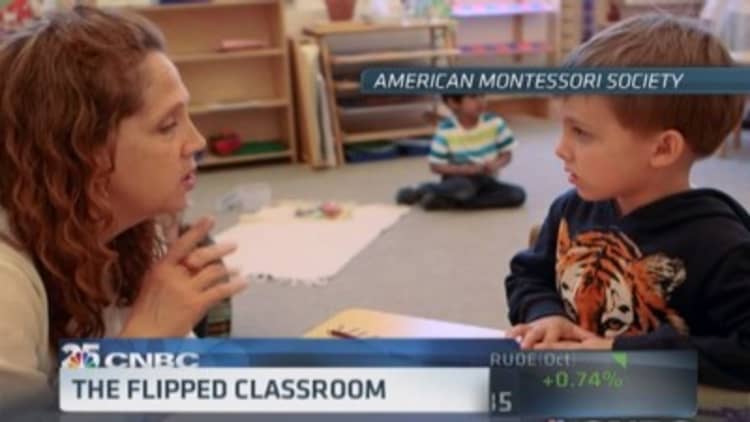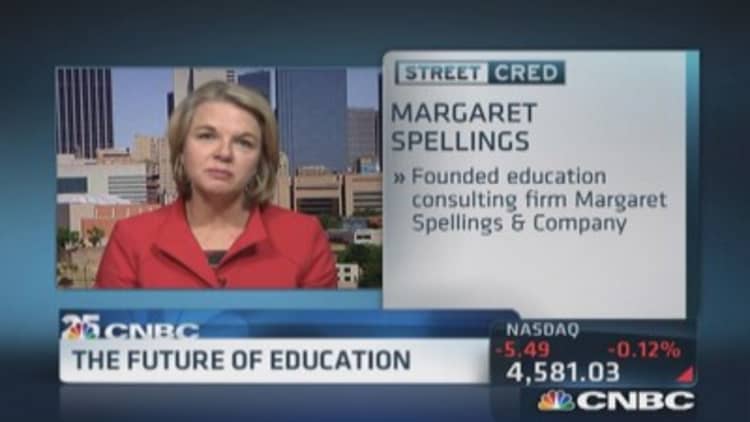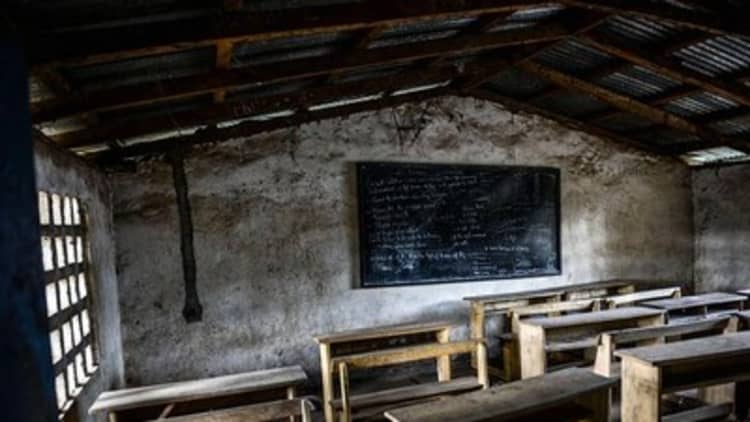
To walk into a college classroom today is to take a trip back in time.
Odds are, the room will have desks arranged in rows, with open space or a lectern at the front of the room. Professors will be using that space to lecture as students sit and listen passively.
That classroom structure has changed little since the late Industrial Revolution, when child labor laws and the shift from farm to factory work for adults brought more children into schools. But is passively absorbing information really the best way for students to learn today?
Hardly, say experts.
"Our educational system is not broken; it's fundamentally obsolete," said Naveen Jain, an entrepreneur and education philanthropist. Jain believes the classroom as we know it was perfectly suited to conveying information when the world was a more static place. But with the pace of change accelerating in virtually every discipline, he said, "the classroom has to be about more than delivering information—a place where children come together in a group and solve problems in an interdisciplinary way."
Jain is describing active learning, where students engage in problem solving and group work using newly acquired information, and research shows it can dramatically boost students' retention of information. According to a study published earlier this year in the Proceedings of the National Academy of Sciences, students' average exam scores rose 6 percentage points, on average, in active-learning environments. The study, focused on students studying science, technology, engineering and math, or STEM subjects, also found that without active learning, a student's chance of failing increased by 50 percent.
Another recent study, focusing on different sections of an introductory biology class at the University of North Carolina at Chapel Hill, found that active learning is particularly beneficial to African-American students and first-generation college students. All students' test scores combined rose more than three points in classes structured around active learning, but African-American and first-generation students in active-learning classes saw scores rise more than six points.
Active learning, however, requires that classrooms operate very differently. Although physical classrooms will likely continue to exist a decade or more from now, some classes will be held virtually. But whether classmates are meeting face-to-face or online, some experts say our new understanding of how students learn best may mean the demise of the classroom as it is organized today.
"By necessity, most universities in the next 10 to 15 years will be moving toward an engaged learning experience," said Jed Sparks, an ecology and evolutionary biology professor and director of undergraduate biology at Cornell. He is already moving in that direction: Cornell's biology department is adopting an engaged learning model for several fall courses.
Our educational system is not broken; it's fundamentally obsolete.Naveen Jainentrepreneur and education philanthropist
In the active-learning class model, students absorb factual knowledge on their own time, often watching videos created by professors. Students can take as long as they need to absorb the material rather than having to take it all in during a fixed class period. Then, when they come to class, they work actively with the information they just acquired, often in groups. Frequent assessments help professors understand immediately how much students were able to absorb, so they can tweak the classroom activities accordingly.
Read MoreHeight and light—how schools are changing inside and out
"I'm so amazed when that student goes through that lecture course how little they retain," said Sparks. "Whether the professor is a great researcher and a bad teacher, or a great teacher, doesn't matter. Research shows that people only learn when they are actively engaged."
Higher-level classes are more likely today to include active learning, Sparks said. Large lecture-based introductory classes, he said, need the most change. That need was also identified in a report by the President's Council of Advisors on Science and Technology, which found that fewer than 40 percent of students entering college planning to major in a STEM subject actually did; the report recommended that STEM professors engage students in active learning to keep more of them in STEM fields.
Active learning may mean covering less ground, Sparks cautioned, estimating that students may cover 20 to 30 percent less material. But he believes the gain in students' retention of information is worth it. "If you can get 60 or 70 or 80 percent retention versus 10 percent more material, which one is better?" he asked.






Still, while active learning may go a long way toward helping students retain information and develop as problem solvers and critical thinkers, it is less obvious that it can help tackle the issue of access to education.
Read More
Today, many Americans lack the means to attend college, and many of those who do start on working toward a college degree fail to finish. A system based around closely supervised classroom work seems unlikely to boost access to college—at least at first glance.
But some visionaries believe it is possible to bring active learning to a broader audience, increasing both the quality of education and its reach.
Technology will be one key to spreading active learning. At the Minerva School at KGI, a venture aiming to reinvent university education, students learn the factual material on their own and then come together in virtual seminars to work with it. The professor can see them at any point, and they are required to be actively engaged in the seminar at all times. On occasion, they are grouped virtually for debate and problem solving, and the professor regularly assesses their work.
Read MoreLecture hall or laptop? Students go online
Minerva aims to attract the best and brightest students and faculty, but Ben Nelson, a tech entrepreneur who founded the program, said its approach can also help underserved and underperforming students. In a traditional classroom, "they are completely zoned out and they're getting nothing," he said, but without the required interaction with students and teacher, there is no immediate way for a teacher to notice their difficulties. "When you actively engage them, they learn," Nelson said.
Some believe that students may not need intensive tech resources to engage in active learning. Sugata Mitra, a professor of educational technology at Newcastle University in the U.K., conducted an experiment in which he cut a hole in the wall, separating his office building from the adjacent slum, and installed a computer on a shelf. The village children managed to teach themselves enough English to operate various programs on the computer.
Repeating the experiment in other villages produced the same results: Even when the computer contained complex educational information on DNA replication in English, the children mastered it. Mitra, who in 2013 received a TED prize for his work, has partnered with the tech company NIIT to launch Hole-in-the-Wall Education, a program aimed at facilitating learning for impoverished children through free, public access to computers.
MOOCs, or massive open online courses, are another education innovation that may help change the classroom as we know it. When colleges offer lectures online, they are essentially taking the old classroom model to cyberspace, dramatically increasing a professor's reach.
Still, most MOOCs today are simply extensions of the traditional lecture-based teaching model, and students are no more engaged than they are in static classroom lectures.
Read MoreOnline courses trim billions in personnel training
In addition, most people who enroll in MOOCs fail to finish the courses. And MOOCs mostly reach people who already have a fair bit of education. Some 74 percent of people taking MOOCs already have a college or graduate degree, and almost 40 percent are in the U.S., according to moocs.com.
Some education experts believe MOOCs can go further. Maggie Little, director of the Kennedy Institute of Ethics at Georgetown, joined with several colleagues to create and launch a MOOC on bioethics last spring. This year, she plans to use the MOOC as a sort of living textbook for the Introduction to Bioethics class.
The class will meet twice a week, Little said, working on projects and the like. "In bioethics, you can't really tell if you understand something unless you write a paper," she said. The MOOC was expensive to create, she said, but it can now be delivered to anyone, and anyone can use it as a text for a class.
Little believes today's typical classroom structure is neither educationally rich nor financially sustainable. "We can't afford to be what we are now for much longer unless we do something radically different," she said. "It doesn't mean the disappearance of brick-and-mortar places. But it means rethinking what is the value added of having a highly personal, highly immersive experience."
—By Kelley Holland, special to CNBC.com





